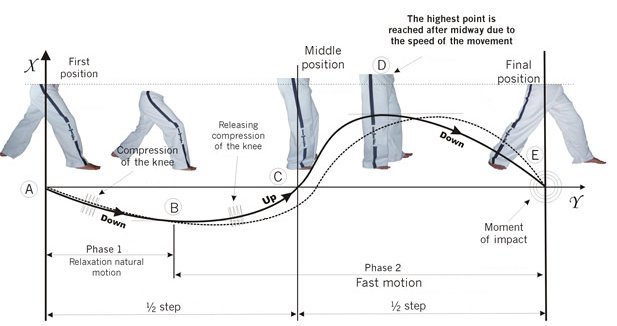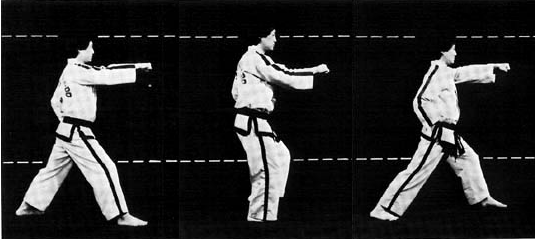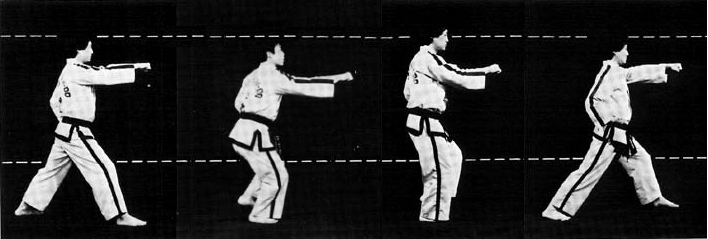- THE CLUB
- TAEKWON-DO
- GRADING
- THEORY
- TECHNIQUES
- PATTERNS
- SPARRING
- OTHER
![[ultkd]](../img/orgs/ultkd_logo.png)
![[tkd]](../img/tkd/tkd-vert-black.png)
The sine wave motion is unique to modern ITF Taekwon-Do, and is variously considered to be vital, controversial, or entirely useless, depending on your point of view. It refers to a vertical component of movement introduced into techniques.
The stated purpose of sine wave is to maximise the power of each technique by using body mass and kinetic energy as efficiently as possible, and to ensure control over body movements enabling smoother changes in direction and transitions from one movement to another. It should be noted, for sake of accuracy, that the TKD sine wave is not really a sine wave as defined by a mathematical function, but is actually an irregular waveform (see the diagram below) .
Figure 1: Sine wave as currently practiced by the ITF

Originally, Tae Kwon Do was indistinguishable from the karate from which it originated, with no up and down motion at all. At this stage, techniques were performed with more emphasis on the hip twist to generate power, and the use of the knees being very slight if at all.
As TKD developed into a distinct art in its own right, changes were made to differentiate it from karate. One such change was to increase use of the knees during movement to create a more natural flow to the techniques; initially this was called 'knee spring', or sometimes 'natural motion'. The primary focus for power was still the hips, but with the knee spring the techniques were not so rigid as in karate. At this point the knee spring acted more to generate a reaction force than to create a vertical movement; the knee is bent and the heel raised, but without an overall change in height of the body. As the heel is lowered and the leg snapped straight, the reaction force allows for more forceful impact of the technique.
In 1983, at a seminar in Derby, UK, a more deliberate vertical element to techniques was introduced, whereby the body was raised up at the start of the movement and allowed to drop back into the stance as the technique was performed, alongside a less emphasised hip twist (see Figure 2 on Diagrams tab). General Choi insisted that this and this alone was 'pure' Taekwon-Do, and that any groups practicing the older style were fakes.
In 1985 the Complete Encyclopædia was published, and showed three methods of moving (volume 4, pp 203-209):
Of the three, sine wave was noted as the only posture used in Taekwon-Do. It was further explained that "Bending the knee slightly gives the leg greater flexibility, imparting more momentum and speed to the motion.". Performed this way, the additional impact force would be generated by dropping the entire body back into the stance.
In the 1990s, a further element was added to the sine wave. An initial compression of the knees created a downward motion before the body was raised upwards, creating a down-up-down motion distinct from the previous way of performing the sine wave (see Figure 3 on Diagrams tab). Once again, the implication was that anyone performing any other style were not practicing 'true' TKD. The current style of sine wave as promoted by the official ITF(s) generates power entirely from this rise and fall, with the hip twist being eliminated entirely.
Figure 2: Sine wave as introduced in 1983:

Figure 3: Sine wave as introduced in the 1990s:

General Choi's explanation was that the introduction of sine wave allowed more force to be generated in accordance with scientific principles. There are contrasting opinions on this point alone; but seasoned observers point to more personal reasons as being the driving force behind the changes.
In 1980, General Choi led a demonstration team to North Korea. This made a lot of his instructors unhappy; and together with pressure applied by the South Korean government to Korean instructors particularly, led to a number of defections from General Choi's ITF; either to the WTF or to form independent organisations. It has been posited as a theory that the introduction of the sine wave method of performing techniques in 1983 was a reaction to these defections - anyone not performing the new way was doing it wrong, and thus could not be practicing Taekwon-Do.
Similarly, a number of later resignations of instructors, most notably Park Jung Tae in 1989, has been proposed as the reason behind the move to the newer style of sine wave in the 1990s. GM Park was one of the most senior instructors in the ITF; particularly as in his role as technical director he was the man primarily responsible for delivering training worldwide, most importantly the International Instructor's Course. Following GM Park's departure and his setting up of the Global Taekwon-Do Federation in 1990, General Choi himself began to take more responsibility for delivering training, and used this to declare that the previous method of teaching was wrong, and that his new sine wave was the correct way to perform techniques.
Despite the General's insistence that his was the correct way to perform moves, groups that parted from the ITF prior to changes being made argue that they are practising TKD as it was originally conceived; and thus they are performing it correctly as they had learned from the General himself, rather than the newer modified version. These groups often label themselves as 'original' or 'traditional' TKD, to distinguish from the ITF's 'modern' TKD. This applies equally to those who split before either sine wave was introduced; thus there are are groups who practice much like the original Karate style, such as GM Cho's AIMAA, as well as those who adhere to the earlier method of sine wave, such as the TAGB.
The table below shows how the different types of motion are affected by adding sine wave:
| Motion | Sine Wave |
|---|---|
| Ordinary | One full sine wave and breath per technique. |
| Continuous | Two techniques are performed with one full sine wave per technique; each technique starts immediately after the end of the previous one (e.g. Dan-Gun 13-14). Where more than two techniques occur, the first is a full sine wave and subsequent techniques are truncated whereby the 'up' follows directly after the 'down' of the previous technique (e.g. Po-Eun 6-12). In both cases, one breath is used for the sequence, with a sharp exhalation to emphasise each technique. |
| Fast | One sine wave and breath per technique; after completing the 'down' of the first technique move straight into the 'up' of the second using the impulse from the first to power the second, i.e. a full sine wave on the first technique, a shortened sine wave on the second (e.g. Do-San 15-16). Exception: where two kicks are performed in fast motion (e.g. Hwa-Rang 18-19, Choong-Moo 14-15) there is no sine wave at all. |
| Connecting | Two techniques are performed in a single full sine wave and with a single breath, although exhalation should only be heard on the second technique . |
| Slow | One full sine wave and breath per technique. |
Related Links: